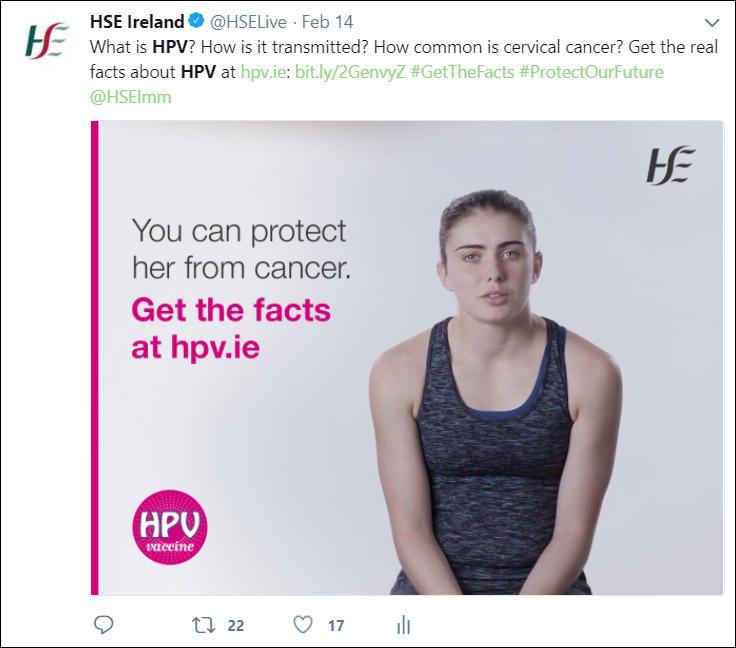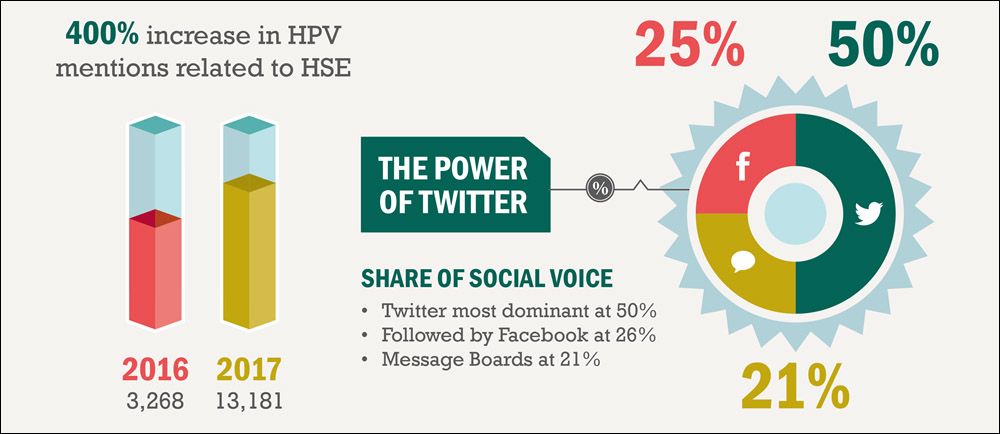Published by Frances Plunkett and Muiriosa Ryan, Social Media Leads
Ireland is one of the few countries in the world to successfully reverse falling HPV vaccination rates.
In 2017, the HPV vaccination uptake rates increased by 12 percentage points in Ireland. Here’s how we used social media, as part of an integrated campaign, to achieve this.
Background
The HPV vaccine is a life-saving vaccine. It protects against the human papilloma virus (HPV) which causes 7 out of 10 types of cervical cancer.
International studies have found the vaccine to be safe and effective. It is supported by leading global health organisations, including the World Health Organisation (WHO).
HPV vaccine uptake rates
In 2014 - 2015, the vaccine had an uptake rate of 87%. However, in 2015 and 2016 scare stories about the HPV vaccine began to circulate via word of mouth and on social media.
These stories claimed that the vaccine was damaging girls and causing a range of debilitating injuries. HSE vaccination teams began to notice resistance to the vaccine at school vaccination clinics.
Concerned by this, the HSE National Immunisation Office sought the help of the HSE Communications Division to counter the misinformation about the vaccine and reassure parents that it was safe.
HPV campaign 2016
In 2016, we partnered with the Irish Cancer Society and put a campaign in place. Despite our efforts, the vaccine uptake rate for the 2016/17 school term dropped to 50%. A new approach was needed.
HPV #ProtectOurFuture campaign 2017
A key learning from the 2016 campaign was the power of individual stories and social media.
Following our research, we updated our messaging and images, focusing on a mix of facts and stories.
Our main concept was “What is a vaccine? It is protection.”

We wanted to repair some of the damage to confidence in the HPV vaccine, as a result of misinformation and scaremongering.
We needed to present a personable, trustworthy tone of voice alongside sound medical advice from experts. We wanted to raise overall awareness of the subject, so that when the audience needs to find out more, they would know to come to the HSE first.
We used video to share the true story of young girls’ experiences of getting the vaccine. We also told the story of a mother who was diagnosed with cervical cancer and how that experience affected her decision to get her daughter vaccinated.
Using social media
Social media was an ideal tool to communicate our messages.
Facebook is the most popular social network in Ireland. Its audience is 86% female and the majority of users are in the 25 - 44 age category.
Through Facebook, we served specific messages to relevant audiences with geo-targeted posts. This was very useful, as the vaccine uptake was particularly low in certain areas.
#ProtectOurFuture
Using the #ProtectOurFuture hashtag we were able to get journalists, health professionals and influencers to join in the conversation and share our messages.
We worked with our media agency to share these stories using a mix of mix of organic and paid social content.
A specific goal was to increase awareness of the safety and effectiveness of the vaccine among parents and their daughters.
Another goal was to direct people to our new website. The site provides further information on the vaccine.
Social media monitoring
In our previous campaign, we were actively participating in conversations on social media and using that channel to present our facts. For the #ProtectOurFuture campaign in 2017, we decided to monitor comments on social channels rather than actively engaging in the conversation.
Discussion took place on all the posts but the conversations included debate from both pro and anti-HPV vaccine supporters. Our content gave HPV vaccine supporters a voice in the wider conversations around the vaccine and a safe space to say, “I’ve had the vaccine. I’ve protected my daughter with this vaccine.”
HPV 2017 campaign results
Uptake of the vaccine increased from 50% in 2016 to 62% in 2017.
Our social media results show an increase in confidence in the vaccine. They reinforce the HSE website and vaccination teams as the place to get the facts on HPV vaccine and cervical cancer.
Facebook
Our Facebook campaign received almost 8.7 million impressions.

We had over one million views on our HPV videos and our Facebook posts attracted over five thousand comments. The HSElive Facebook page also gained over 3000 new likes as a result of the campaign.
Twitter
The potential reach of HPV mentions linked to HSE went from 500k in 2016 to 3.2m in 2017.
Twitter was the most dominant platform in terms of share of voice at 50%. There was a 400% increase in HPV mentions on Twitter.

The #ProtectOurFuture hashtag had a reach of almost 250k and potential impressions of 595k. Importantly the hashtag focus also shifted from negative to positive in 2017.
Another significant turnaround which was evident across social media and news sites was the shift away from fake news. The most read and shared news articles about HPV in 2017 were based on HSE PR statements compared to 2016 where fake news articles dominated.
Word of mouth
Social is word of mouth on a grand scale. It gave us the power to deliver our messages directly to the parents and daughters considering the vaccine at the time when it was top of mind.
It also allowed us to take control of the narrative about the vaccine using our hashtag.
Success
The success of #ProtectOurFuture 2017 is down to the integrated nature of the campaign, and the team effort behind it, rather than any one element.
The partnership work between National Immunisation Office (NIO), HSE Communications and the national network of immunisation teams was instrumental in the success of the programme and the campaign. The support of the Irish Cancer Society and the HPV Alliance has also consolidated voices of authority about the vaccine.
We still have a long way to go get vaccination rates back to previous high levels but we continue to work hard to achieve this.
Watch this space.
#ProtectOurFuture
www.facebook.com/HSElive
www.hpv.ie